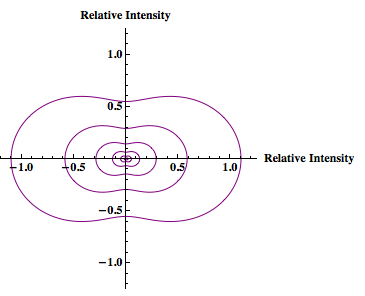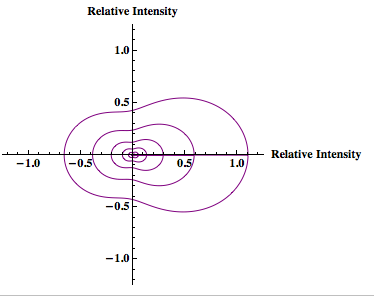For my project I also wanted to look at the Rayleigh predicted scattering intensity for a particle size larger than the Rayleigh limit and compare that to the Rayleigh-Debye predicted scattering intensity.
Polar plot depicting the Rayleigh Relative Scattering Intensity for scattering angles from 0 to 360 degrees for Particle Sizes larger than the Rayleigh limit
The wavelength used was 400 nm or violet light in the visible spectrum since this is the shortest wavelength in the visible spectrum and as a result has the smallest Rayleigh limit. The particle sizes used were 50, 60, 70, 80, 90, 100 nanometers in diameter.
Polar Plot depicting the Rayleigh-Debye Relative Scattering Intensity for scattering angles from 0 to 360 degrees.
The same particle sizes and wavelengths were used as in the Rayleigh scattering graph above.
As you can seen in the graphs above the Rayleigh predicted scattering intensity is the same for forward and back scattering. While the Rayleigh-Debye predicted scattering intensity occurs mainly in the forward direction. Larger particles (outside the Rayleigh limit) should scatter more light in the forward direction, as in the Rayleigh-Debye graph, which shows that the form factor introduced in Equation [5] is necessary to predict the scattering intensity of larger particles.
Here is a link to show the differences between Rayleigh Scattering and Mie Scattering as particles become larger in size. http://www.mwit.ac.th/~Physicslab/hbase/atmos/imgatm/mie.gif
The similarities between the image of Mie Scattering depicted in this link and the Rayleigh-Debye scattering shown in the graph above suggest that the Rayleigh-Debye equation is both an accurate and simpler method for calculating the scattering for particles larger than the Rayleigh limit.
Below is a link to all the Mathematica files used to create the preliminary results, these results, and find the concentration and scattering intensity used in the testing of the Static Light Scattering Theory.




Your graphs illustrate the difference here really well! It would be interesting to see the Mie scattering equations to compare them to the Rayleigh-Debye ones so we could appreciate what we’re avoiding.